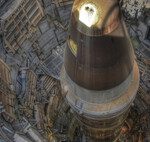First modification: Last modification:
After failed attempts in the summer, the Artemis I mission finally took off successfully this Wednesday, November 16, the first of three operations that aim to take humans to the Moon and prepare an eventual trip to Mars. This expedition, 50 years after the Apollo mission that took man to that satellite for the first time, left from the Kennedy Space Center in Florida (United States), without crew members on board.
Start a new era of space exploration. The Space Launch System (SLS) and the Orion capsule are on their way to the Moon, which will last about a week, after they lifted off on the Artemis I mission on Wednesday, November 16.
The SLS, the largest and most powerful of all NASA rockets with a height of 98 meters, lifted off at 1:47 a.m. (local time) from Pad 39B at the Kennedy Center in Cape Canaveral, Florida, making its way in the darkness of the early morning.
“Today is a great day,” NASA Administrator Bill Nelson said after liftoff, when the Orion spacecraft had already separated from the first stage of the booster and was continuing on its journey to the Moon.

This launch was possible after several failed attempts last summer, due to adverse weather conditions and technical problems. Among these was the fuel leak in one of the rocket engines.
However, the mission had years of delays also due to technical problems that caused budget overruns of billions of dollars.
On board there are no crew members but mannequins made of material that simulates human tissue. They will measure cosmic radiation, one of the greatest space hazards.
The SLS is expected to sustain a mission of around 25 days, in which it will travel more than two million kilometers, before returning to Earth on December 11, in the middle of a controlled ditching in the Pacific Ocean.
Artemis I, the first of three missions to take humans to the Moon and eventually Mars
The liftoff marked the start of NASA’s Artemis lunar exploration program, named after the mythological twin sister of Apollo, the mission that first landed astronauts on the Moon 50 years ago.
If all goes well, the Artemis 2 mission will launch in 2024, with astronauts going around the Moon, but not landing on the surface, similar to what Apollo 8 did.
Subsequently, by 2025, Artemis 3 is scheduled, although it may not take place until 2026, according to an independent audit of the plan. For that occasion, NASA plans to take two non-astronauts to the lunar surface.
“They’ve earned their place in history,” Charlie Blackwell-Thompson, launch manager for NASA’s Earth Systems Exploration Program, told her team after liftoff.
Orion should reach the Moon next week, more than 370,000 kilometers from Earth. After coming within 130 kilometers of the Moon, the capsule will enter a distant orbit that will extend about 64,000 kilometers.
Some experts point out that beyond the return of humans to the Satellite, the mission seeks to explore the solar system, including Mars, asteroids and solve problems related to Earth.
NASA hopes to conclude this test flight before introducing the astronauts who will be on the next mission, who will follow in the footsteps of Apollo 11’s Neil Armstrong and Buzz Aldrin.
With Reuters and AP














